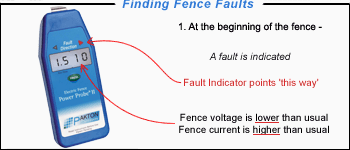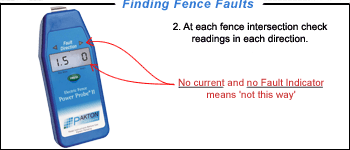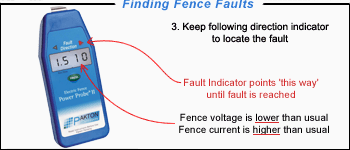Electric Fence Power Probe® User Instructions
Introduction
The Digital Electric Fence Power Probe® is the most technologically advanced electric fence fault finder available.
It features a micro processor and surface mount technologies to make it the easiest to use and most effective electric fence fault finding device ever made.
The Power Probe is able to show the peak voltage, peak current and direction to the fault (of current flow) in all electric fences, irrespective of energiser* and faults.
The Power Probe needs no second (earth) connection to read fence voltage as it uses the capacitance of the user's hand (nothing is felt). As such the way it is held (hand position) may slightly effect voltage reading accuracy.
This is a small price to pay for the convenience of no wires to tangle or break.
*See: Important Notes below.
Unpacking and checking
All Power Probes are shipped ready to use with the battery connected.
Press the button marked "Press"; a decimal place should appear on the left hand side of the display.
If nothing is shown or a battery symbol is shown then replace the battery. To replace the battery, unscrew the four large screws from the back of the Power Probe and lift the back off carefully.
Fit the new battery into the unit, making sure to match '+' to '+' and '-' to '-'.
Note: If "8.8:8.8" is shown continuously after fitting a battery, disconnect the battery, wait five minutes and reconnect the battery.
If the Power Probe fails to reset again then the battery may be very flat. DO NOT leave a flat battery in the Power Probe.

Types of Electric Fence Faults
There are two common types of faults on electric fences. An OPEN CIRCUIT is where the live wire is broken.
This leads to no voltage at all on the sections after the break. These are relatively easy to find by testing the fence for voltage.
A SHORT CIRCUIT is where the live wire touches ground or an earth wire, or an insulator breaks down.
This leads to a reduced voltage throughout the system and no (or little) voltage at and beyond the fault.
When a SHORT circuit occurs a large amount of current flows through the live wires.

Checking your fence
Use the POWER PROBE to measure the voltage on the fence by placing the metal tip over the live wire. The reading is shown by the numbers on the left side of the display. If it is lower than usual then you may have a short circuit. To be an effective barrier the fence should have in excess of 2.5 kV on it.
Fault Finding Technique
 Always start close to the energiser - where the lead out wire is connected to the fence is a good place to start.
This way you will always start on the energiser side of a fault. If the voltage is lower than usual and the current is higher than usual then you may have a short circuit.
Follow the direction arrows towards the fault. If the Power Probe shows faults in more than one direction always follow the direction with the worst (highest) current reading.
The fault direction arrows will light when the Power Probe calculates that the leakage (load) is worse than an acceptable value.
Always start close to the energiser - where the lead out wire is connected to the fence is a good place to start.
This way you will always start on the energiser side of a fault. If the voltage is lower than usual and the current is higher than usual then you may have a short circuit.
Follow the direction arrows towards the fault. If the Power Probe shows faults in more than one direction always follow the direction with the worst (highest) current reading.
The fault direction arrows will light when the Power Probe calculates that the leakage (load) is worse than an acceptable value.Note that, for a multiwire fence the current flow will be seen on the "feed" wire but not on the "blind" (dead-end) wires.
Take the time to "play" with the POWER PROBE. Place pretend "faults" (short the live wire to grounded metal) on your fence and "find" them. The experience will be invaluable when you come to find "real" faults. Get to know the "usual" current used by your fence and the "usual" voltages around the system. With long fences the "usual" current reading may be as high as 5 Amps. This will also depend on seasonal conditions such as grass and moisture.
Specifications and Important Notes
Specifications: Voltage: 0.2 to 9.9KV (peak) +/- 10%
Current: 1-32 Amps (peak)
Important Notes:
- To be used for testing agricultural electric fences only.
- The Power Probe is unable to operate correctly on very small energisers i.e. those incapable of powering more than 2 Km of electric fence. The voltage reading may be low by up to 25%
- The Power Probe may be damaged if connected to electric fences with higher than 10KV peak voltage.
- The case IS waterproof!
Problems with the Power Probe
The most common cause of problems with the Power Probe is flat or poor quality batteries. If your Power Probe fails to operate, shows no readings, or shows "8.8:8.8" on the display, check the battery. To access the battery, unscrew the four large screws from the back of the Power Probe and lift the back off carefully. If you don't have a battery tester or meter fit a new (heavy duty or alkaline) battery and see if the problem disappears.
Warranty
The Power Probe is covered by a 12 month warranty against defective parts (excuding batteries) or workmanship. Please see "For assistance" if you have any problems or contact the store of purchase or distributor.
For further assistance
Our contact details are shown here.
